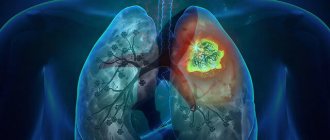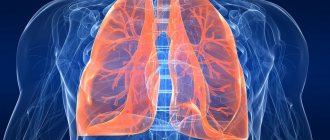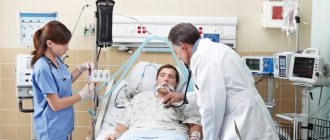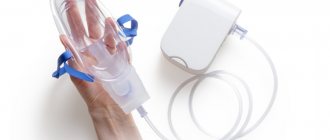What loads are allowed for pneumonia?
Forget about classic fitness! Whatever the cause of your illness (a complication of the flu or coronavirus), you cannot train until you have fully recovered. “Sports activities for pneumonia are strictly contraindicated, but physical therapy is recommended: it speeds up the healing process,” says Andreas Stromberger, head of the rehabilitation department at the Center for Congenital Pathology, a specialist in manual therapy and physiotherapy at the GMS Clinic.
Active sports training can aggravate the course of the disease. But you shouldn’t give up movement completely: as your condition improves (weakness gradually goes away, breathing becomes easier) and after consulting a doctor, you can start doing breathing and rehabilitation exercises. “When to start exercise depends on the severity of the disease: the more severe and prolonged it is, the more time it takes to recover,” notes Andreas Stromberger. - Be patient".
The right exercises will help speed up your recovery. “The integrated use of exercise therapy tools and methods that affect the main mechanisms of disease development will help reduce recovery time,” adds Yesenia Kalyuzhina, a rehabilitation specialist at the SportMedica sports medicine clinic.
What do such exercises give? “They train the physiological patterns of exhalation and inhalation, strengthen the respiratory muscles, improve the function of healthy lung tissue and counteract the occurrence of adhesions,” reminds Yesenia Kalyuzhina.
Plus, such a light load increases the overall tone of the body, which is also important during the recovery period after pneumonia.⠀
Myocarditis and other heart diseases
Many patients with severe coronavirus are at risk of damage to the heart muscle. Even those patients who have not previously had any cardiovascular pathologies are not immune from these diseases in the future.
Myocardial damage due to COVID-19 is a consequence of:
- direct toxic effects of the virus on the myocardium;
- blood clotting and circulatory disorders;
- cytokine cell damage;
- cardiac hypoxemia (lack of oxygen);
- damage to the endothelium of the coronary vessels.
According to the data and forecasts of the international database PubMed, patients who have recovered from coronavirus of CT-3 and CT-4 severity may in the future go to medical institutions with cardiomyopathies and arrhythmias.
In this regard, to monitor their health status, patients are advised to do the following:
- Complete blood count (C-reactive protein, sometimes rheumatoid factor and troponin);
- Blood test for vitamin D, iron, ferritin (low levels are symptomatic of weakness and tachycardia);
- ECG;
- EchoCG;
- Holter ECG (sometimes, according to the testimony of the attending physician);
- MRI of the heart with contrast (if myocarditis is suspected).
Diagnosis and treatment are carried out under the supervision of a physician specializing in cardiology and functional diagnostics.
During the rehabilitation period after coronavirus, the patient is prescribed cardioprotective medications, as well as drugs that strengthen blood vessels and the heart muscle (including vitamin and mineral complexes: Omega 3, Coenzyme Q10, vitamins A, C, E, P, F in the absence of individual intolerance).
Also important:
- A healthy and balanced diet (you should avoid foods high in bad cholesterol);
- Adequate rest and sleep;
- Walking and exercise (not immediately, as recommended by your doctor).
Gymnastics for pneumonia: what you need to know
As we have already said, exercise therapy and breathing exercises are one of the elements of a comprehensive recovery program for pneumonia. “Physical exercises during (and after) COVID-19, pneumonia, bronchitis and pleurisy should begin with exercises that promote drainage of bronchial cavities and abscesses,” explains Yesenia Kalyuzhina.
Drainage is provided by exercises for the chest area, which stimulate blood circulation and mucus movement. “The patient is placed in such a position that the area of the lung lesion is located above the bronchus (or bronchi) draining it,” notes Yesenia Kalyuzhina. “Thanks to this, during special exercises, phlegm, under the influence of gravity, enters the main bronchus and reaches the trachea, causing an involuntary vigorous cough, with which it leaves the body.”
Most often, the rehabilitation complex includes simple joint exercises. “These include, for example, active (but not sudden) movements in the joints of the upper and lower extremities, a combination of exercises for the muscles of the back, chest and diaphragm, stretching, tapping movements,” adds Andreas Stromberger. — They also use special breathing devices and simulators. Regular exercise helps restore the respiratory muscles, strengthens muscles and improves breathing.”
There are several types of breathing and rehabilitation exercises; discuss the possibility of using them with your doctor. We asked Yesenia Kalyuzhina to show us a set of exercises for pneumonia that will speed up recovery.
When can you start rehabilitation?
Many who have experienced what coronavirus is complain of shortness of breath, fatigue, attacks of dizziness and other similar disorders. Their presence indicates continued changes in the condition and functioning of the lungs. The rehabilitation program is largely aimed at eliminating them.
They begin to work on restoring the body after a coronavirus infection, and especially pneumonia, with the permission of a doctor after the acute inflammatory process has completely stopped and body temperature has normalized. It is important to exclude the presence of disorders of the cardiovascular system and kidneys, since in such situations recovery will be carried out according to a different, special program.
Rehabilitation should begin as early as possible, as this will ensure the best effect, but you should not rush too much, so as not to provoke a deterioration in your well-being. The best option would be to obtain permission from the attending physician, which most patients are granted 20-25 days after the start of treatment.
Expert Opinion of a Doctor
It is important to approach each patient individually and develop a comprehensive program in order to achieve the necessary results as quickly and effectively as possible.
Gritsenko Konstantin Anatolievich
Neurologist, chiropractor, vertebroneurologist
Experience: 29 years
Ask a Question
How to build a lesson
Start with 5-10 repetitions of each exercise and gradually increase this number as you adapt. If you feel very weak, reduce the number of repetitions.
Follow this program every other day.
Move smoothly, try to breathe deeply and evenly.
Monitor your well-being. “The following symptoms should alert you: shortness of breath, cough, pain in the chest and intercostal space, increased frequency of respiratory movements (RR). Normally there should be from 16 to 20 breaths per minute, if there are more than 30, this is a cause for concern,” says Andreas Stromberger.
Before starting training, consult your doctor.
To perform the complex, you will need a chair and a low-resistance expander band.
Everything's under control
– Is it true that vitamin D plays a great role in the restoration of the lungs?
– There has been a lot of talk about this in the last two years, but it seems to me that it is largely dictated by fashion. I believe that it is worth replenishing the level of this vitamin only if tests prove its deficiency. If the content of this vitamin in the blood is normal, then it is not necessary to take it additionally.
Breathe deeply. How to improve lung function Read more
– Are there any drugs that improve respiratory function?
– Yes, but they are not universal. We prescribe medications depending on the symptoms. If a person still has a cough after pneumonia, we prescribe mucoactive drugs. If there is bronchospasm or wheezing, we recommend bronchodilators to dilate the bronchi.
– Hypertensive patients keep a blood pressure monitor at home. Do people who have pneumonia need to buy a pulse oximeter?
– It all depends on the condition in which the person was discharged. Normal saturation (oxygen saturation in the blood) is 95 and above. If the readings are less than 93 units, the person requires resuscitation. When discharging a patient with reduced saturation, we always recommend that he purchase a device to monitor the oxygen content in the blood, as well as an oxygen concentrator. By the way, sometimes saturation decreases only during physical activity, but remains normal at rest. Therefore, measurements with a pulse oximeter are taken before walking and 6 minutes after.
Standing body bends
Stand facing the wall at a distance of 20-25 cm from it, stretch your arms up, press your palms tightly against the wall. Lean your body forward slightly, opening your chest, and relax your lower back. Gently lean your body to the left, bending your left arm, and with your straightened right arm, describing a semicircle along the wall. Then just as smoothly lean to the right, bending your right arm and describing a semicircle along the wall with your left. This is one repetition. Perform 5-10 repetitions of the exercise.
While doing gymnastics, observe your sensations. If your health allows, you can increase the number of repetitions. If you feel weak, reduce it.
Breathing exercises for home: a complete set
Perform all the listed exercises one after another. If you feel weak and dizzy from hyperventilation, you can take a short break for 3-5 minutes and restore your normal breathing rate. Spend 10-15 minutes training 2-3 times a day, if necessary, you can do longer.
Relief from phlegm
Exercise helps you clear your throat and clear your airways for oxygen, which will actively enter the body during exercise.
- Sit on a chair with a flat back; if you feel weak, do the exercise lying on your side.
- Press a pillow, folded blanket or other soft, voluminous object against your stomach and round your back around it.
- Inhale slowly and deeply, feeling the stretch in your chest between your ribs.
- Do not fight attacks of coughing - spit the phlegm into a tray or onto a prepared napkin.
Do the exercise several times until you feel that you can breathe easier. When you cough, press the pillow harder against your stomach, this will help cope with the pain.
Breathing from the diaphragm
Exercise will help saturate the posterior lower lobes of the lungs, which are most affected by coronavirus, with oxygen.
- Lie on a flat, hard surface on your back, bend your knees, and let your feet touch the floor completely.
- Place your palms on your stomach just below the ribs - this will help control the quality of the exercise.
- Inhale slowly through your nose so that your upper chest remains motionless and your stomach rises.
- Hold your breath for a few seconds, feel the stretch in the intercostal space.
- Exhale through your mouth, pulling your stomach toward your spine as you exit.
Repeat the exercise 5-7 times and move on to the next task.
Swing your arms and shoulders
Warming up the shoulder girdle is especially useful for those who often slouch. Constantly rounded shoulders over time lead to deformation of the chest and reduce lung capacity.
- Stand straight with your feet shoulder-width apart or take a straight position while sitting on a chair.
- Place your hands on your shoulders and make rotational movements, first forward, then back.
- Make 10-15 turns in both directions and spread your arms.
- Move full circles forward and backward with straight arms. Try to draw a circle with as large a diameter as possible.
- If you find it difficult, start with a small circle and increase the radius over time.
While moving your arms, take a slow, deep breath in deeply, and while pausing, exhale.
Reduction of the shoulder blades
This exercise will help you get rid of slouching, straighten your chest, and teach you to breathe evenly and deeply.
- Sit on a chair, straighten up, place your feet flat on the floor, and place your hands loosely on your hips.
- Squeeze your shoulder blades together, straightening and stretching your pectoral muscles. While mixing, slowly inhale the air; you should feel your lungs filling with oxygen.
- Hold the pose for 5-10 seconds and exhale, return to your normal position.
Breathing exercises with stretching of the thoracic spine
The exercise is performed lying down, sitting or standing - it is important that the back is straight at all times and the shoulders are turned.
- Raise your arms above your head; for convenience, you can cross them into a lock.
- Stretch your entire body up and back, stretching your chest.
- As you stretch, inhale slowly and hold your breath at the top.
- Exhale and lower yourself to the starting position, repeat the exercise 5-10 times.
Buteyko method
It is based on breathing control through muscle relaxation. Daily exercises teach you to breathe slower, less, and only through your nose. First, a control measurement is performed - the second hand measures the time during which a person, having exhaled, is able to hold back as much as possible from the next inhalation.
The arrow indicates this:
- Pause between inhalations through the nose - 40 seconds or more, pulse - 70: everything is fine
- Pause 20-40 seconds, pulse – 80: first stage of the disease
- Pause 10-20 seconds, pulse – 90: second stage of the disease
If the pause cannot be maintained for even ten seconds, according to the Buteyko method this corresponds to the third stage of the disease.
Training gradually increases the interval between inhalation and exhalation, and makes breathing itself “more economical”: attacks of lack of air occur less and less often. This makes it possible in the future not only to reduce the dosage of drugs used to treat respiratory failure, but sometimes to completely abandon them.
INDICATIONS
The timeliness and appropriateness of exercise therapy for pneumonia is determined only by a pulmonologist. The main goal of breathing exercises is not to harm, but to help cope with a number of unpleasant symptoms:
- dyspnea;
- shallow breathing, inability to take a deep breath;
- paroxysmal residual cough;
- difficulty in removing mucus.
All these signs are residual manifestations of the inflammatory process. They are the hardest to get rid of. As a rule, exercise therapy techniques are used after the end of intensive drug treatment.










